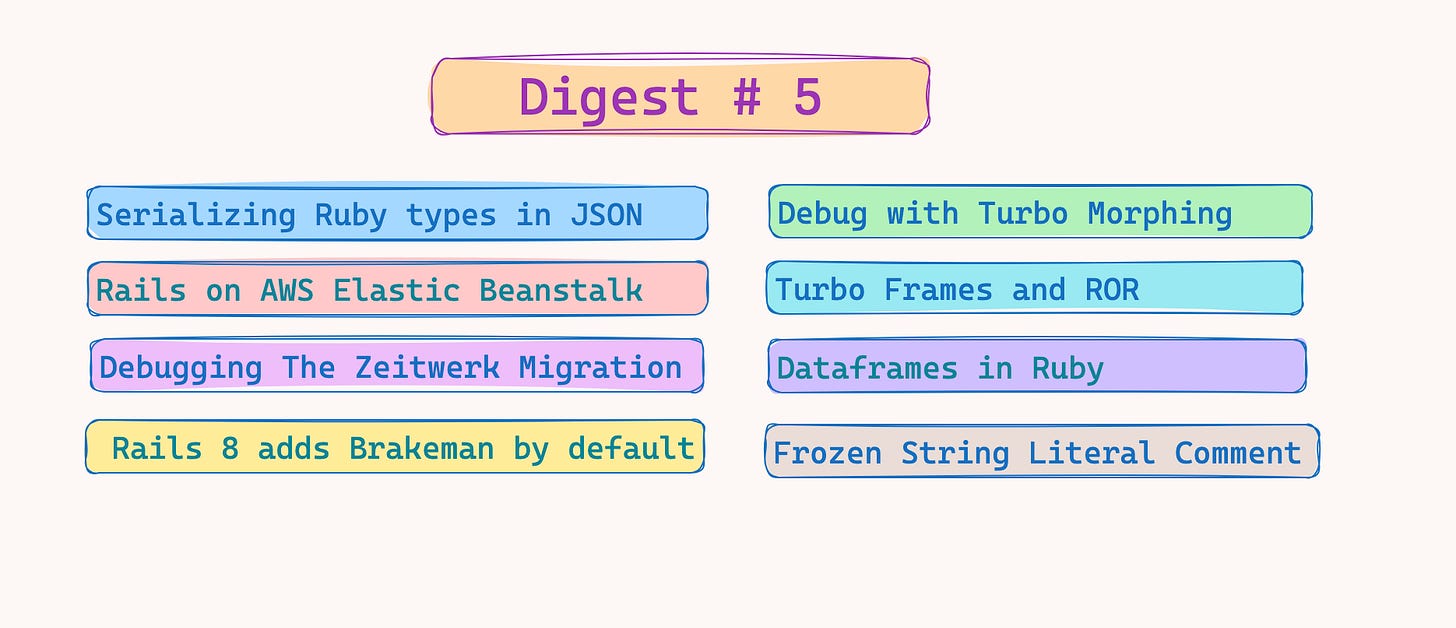Introduction
In this issue, we have picked some interesting articles published last week that are worth reading.These articles cover topics such as Serializing Ruby, Rails on AWS Elastic Beanstalk, Zeitwerk Migration, Scaling Ruby, Dataframes in Ruby, Turbo Frames, RuboCop, Turbo Morphing. Consider subscribing, liking, and sharing it.
Learn to make innovative web apps with Ruby on Rails and unleash your creativity ( Affiliated )
The Complete Ruby on Rails Developer Course
(Bestseller | 4.4 ⭐ | 100k+ students)
Learn to Code with Ruby
(Bestseller | Rating: 4.8⭐ /5 (6k ratings) | 78k students)
1. Serializing Ruby datatypes in JSON
In this blog post, the author discusses the serialization of Ruby datatypes in JSON and introduces a feature that allows for the serialization of most core datatypes using JSON extensions. He starts by demonstrating how the default behavior of Ruby's JSON library converts non-native types, such as Range, Symbol, and Time, into Strings during JSON generation. However, this approach results in a loss of the original datatypes when parsing the JSON back.
2. Running Rails on AWS Elastic Beanstalk
This tutorial provides a comprehensive tutorial on deploying a Rails application on AWS Elastic Beanstalk. The tutorial covers various steps, including setting up an Elastic Beanstalk instance, creating a sample Rails app, and configuring automatic deployment using AWS CodePipeline. Additionally, it touches on optional steps like setting up a custom domain and enabling SSL for the application.
3. Debugging The Zeitwerk Migration
In this blog post, the author discusses debugging techniques for the migration to Zeitwerk in Ruby on Rails applications. Zeitwerk is introduced as the new autoloading mechanism in Rails 6, with Rails 7 dropping support for classic autoloading, making it essential to switch to Zeitwerk for future upgrades.
4. Rails 8 adds Brakeman by default to new applications
The article discusses the inclusion of Brakeman as a default gem in Rails 8 for new applications. Brakeman is a security scanner specifically designed for Rails applications, performing static code analysis to identify security issues throughout the development process. Notably, it requires no configuration; once installed, developers can initiate a scan with a simple command.
5. The Art of Forking: Unlocking Scalability in Ruby
The article explores the introduction of forking capabilities in Karafka, a Ruby and Rails multi-threaded Kafka processing framework, aiming to enhance parallelization and scalability. The author emphasizes that the goal is not to replace threads but to provide additional options for diverse use cases. The piece outlines objectives, focusing on integrating forking effectively into Ruby applications, specifically using Karafka as a case study.
6. What Does the Frozen String Literal Comment Do in Ruby?
The article delves into the significance of the frozen_string_literal magic comment in Ruby, emphasizing its impact on preventing unintended modifications and optimizing memory allocation. This comment instructs the Ruby interpreter to freeze all string literals, ensuring that memory is allocated only once for each literal throughout the script. Magic comments in Ruby serve as directives for the interpreter and must be placed at the top of the script.
7. How to debug issues with Turbo Morphing
The article provides insights into debugging issues with Turbo's morphing feature, emphasizing the complexity involved in its functionality. Turbo morphing, though seemingly magical, can pose challenges when unexpected issues arise. The author shares debugging techniques based on personal experience, aiming to assist developers facing similar challenges.
8. Linear Regression using dataframes in Ruby
The article introduces the concept of linear regression in the context of data science using Ruby, focusing on predicting one continuous numeric variable based on another. Linear regression is explained as a method to determine the relationship between two correlated sets of data, such as predicting the price of a flat based on its size or test scores based on study time.
9. Turbo Frames and Ruby on Rails
The article discusses Turbo Frames, a crucial component of the Hotwire stack, emphasizing their role in creating dynamic and user-friendly web applications within Ruby on Rails. Turbo Frames offer an efficient way to enhance user experience while minimizing reliance on complex JavaScript code. The core concepts of Turbo Frames are explored, presenting them as designated sections within web pages that operate semi-independently, acting as "mini-pages" that can be updated without requiring a full-page reload.
That’s a wrap for this week. If you have any feedback, requests, or improvements for this newsletter consider commenting so that we can work on improvements for the next one.


